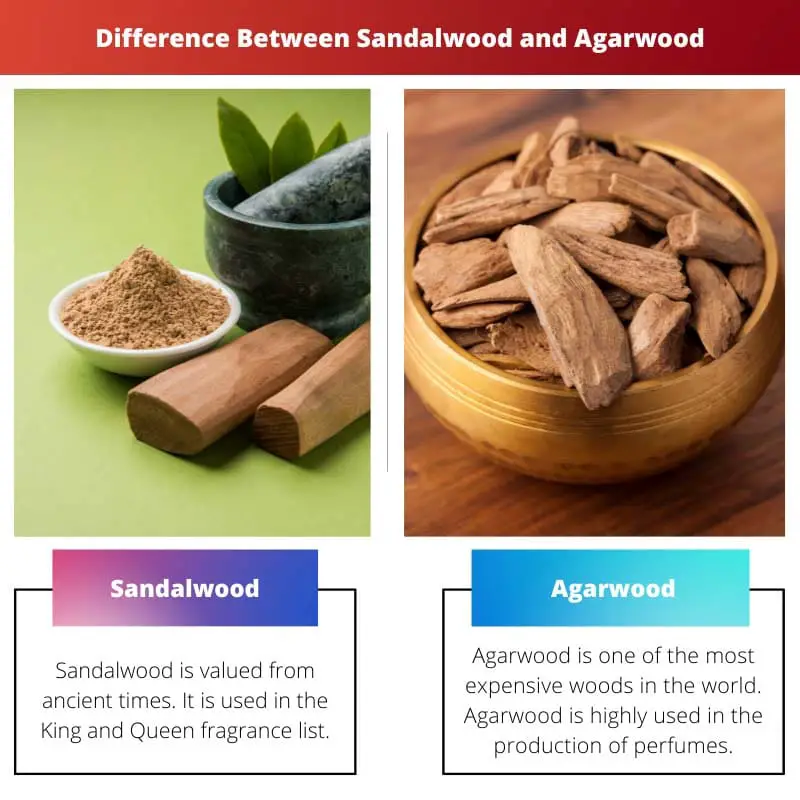Sandalwood and agarwood are two different trees with a wide range of applications. Sandalwood and agarwood have high fragrances and are used in the perfume-making industries.
They are expensive woods in the world. Sandalwood and agarwood have many advantages in the cultivation. But both the sandalwood and agarwood trees take more time to grow.
Key Takeaways
- Sandalwood and Chandan are the same fragrant wood from the Santalum genus trees, while agarwood comes from Aquilaria and Gyrinops.
- Sandalwood has a warm, creamy, and smooth fragrance, whereas agarwood has a rich, complex, deep aroma.
- Sandalwood has medicinal properties and is used in various beauty products, while agarwood is valued for its rarity and is primarily used in the perfume industry.
Sandalwood vs Agarwood
Sandalwood is a type of wood which is used in the making of perfumes. The color of sandalwood is yellow. It is very expensive wood. It takes 30 years to grow. Oil extracted from sandalwood can also be used for different purposes. Oil extracted from agarwood is used in the making of fragrances. It takes 10 years to grow.

Sandalwood is nothing but a tree belonging to the class called woods. The sandalwood comes under the genus called Santalum.
The sandalwoods are heavy, fine-grained, and yellow. The sandalwood can retain the fragrance for decades in the major advantage.
Sandalwood oil is widely used which is extracted from the woods. Sandalwood is considered the most expensive wood in the world. The sandalwood and sandalwood oil have different fragrances, and both of them have many fanatics.
Agarwood is nothing but a dark wood with a heavy fragrance. The agarwood has many names. they are aloeswood, eaglewood, and gharuwood.
The agarwood produces the fragrance by getting infected. A type of mold called Phialophora parasitica causes infection in the heartwood of the tree and then the tree produces dark aromatic resin.
Before the infection, the tree is odorless and pale-colored. The aromatic resin is called aloes. The infection created a dark and dense resin in the heartwood of the tree.
Comparison Table
| Parameters of comparison | Sandalwood | Agarwood |
|---|---|---|
| Founded year | 14th century | 1500 BCE |
| Native | India and Southeast Asia | Southeast Asia |
| Growth period | Sandalwood takes 30 years | Agarwood take 10 years |
| Cosmetic use | Offer anti-aging properties | Offer protection from the sun |
| Oil use | Sandalwood oil used to treat cold and cough | Agarwood oil is used as an ingredient in fragrances. |
What is Sandalwood?
Sandalwood is valued from ancient times. It is used in the King and Queen fragrance list. In the past, the sandalwood is over-harvested, and the sandalwood needs more time to grow.
Sandalwoods are medium-sized trees. They are also called hemiparasitic trees. Indian sandalwood is a notable tress called Santalum album.
The Australian sandalwood called Santalum spicatum also has a great market. These sandalwoods are highly found in India, Nepal, Bangladesh, Pakistan, Sri Lanka, Australia, Indonesia, Hawaii, and other Pacific Islands.
Sandalwood is produced commercially. The high level of fragrance is selling worldwide. Depending on the age and the location of the tree, the yield of the oil varies.
India is the world’s biggest sandalwood producer. Since colonial times, sandalwood was the major economy of the country. The wood from the root and stump provides maximum sandalwood, so the entire tree is blown down.
Indian sandalwood is highly used for the extraction of sandalwood oil. Along with pink ivory and agarwood, sandalwood is one of the most expensive woods in the world.
The sandalwood is used in fluorescence microscopy for its low fluorescence and refractive index. The sandalwood is also used for religious purposes.
The distillation process is happen for the extraction of the oil from the sandalwood. Sandalwood is also used in cosmetics. It also has many health benefits.

What is Agarwood?
Agarwood is one of the most expensive woods in the world. Agarwood is highly used in the production of perfumes, and it is valued in Indian-North Eastern traditions.
The depletion of wild resources is also the reason for the high cost of agarwood. Depending on the geographical location of the trees, agarwood has various species and qualities.
The length of the infection also plays a vital role in the fragrance of the tree. The method of harvesting, root type, branch and trunk also have their purposes and qualities.
The first-grade agarwood is considered the most expensive for its high-quality raw materials. The price of the wood varies with geographical location.
The quality of woods varies with the species and age of the tree.
The price of agarwood is increasing rapidly every year.
The agarwood has a complex and pleasing odor. Agarwood and agarwood oil is valued and used in many traditional functions. It is highly used in ancient civilizations. Agarwood is the fragrance product in the Vedic period of India.
Agarwood has many applications. It is used in various fields other than fragrance. Agarwood has high medicinal value. In the medical text of the Susruta Samhita, agarwood is mentioned.
The trunk and roots play a vital role in the production of agarwood oil. There are about seventeen species of agarwood are available. In a forest with 100 agarwood, only seven trees can get infected and produce fragrance.

Main Differences between Sandalwood and Agarwood
- Sandalwood can keep the incense for plenty of years, but that does not happen in agarwood.
- Sandalwood can grow up to 10 meters, whereas agarwood can grow up to 20 meters.
- Sandalwood is used to treat urinary tract infections, whereas agarwood is used to treat gastric problems.
- Sandalwood belongs to the family Santalaceae, whereas agarwood belongs to the family Thymelaeaceae.
- Sandalwood leaves have antipyretic, antiseptic properties, whereas agarwood leaves have anti-cancer properties.

- https://link.springer.com/article/10.1007/s12231-018-9408-4
- https://lup.lub.lu.se/student-papers/record/8981761
